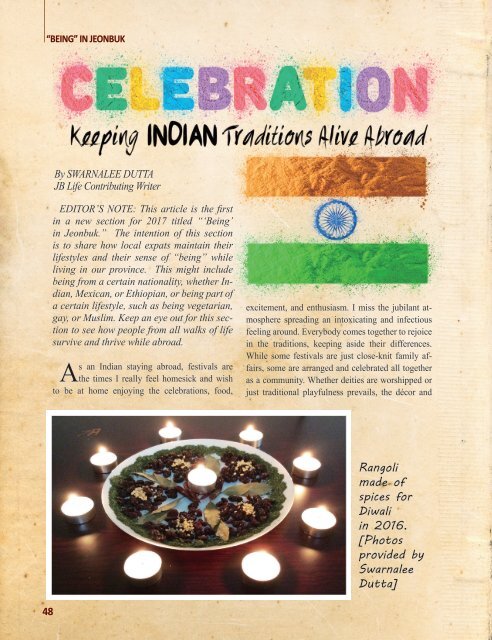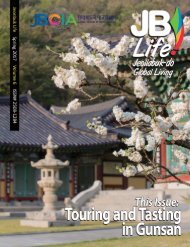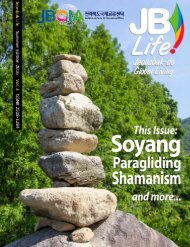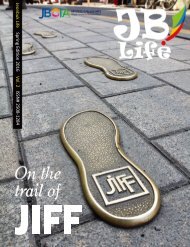JB Life January 2017
Volume 5 (January 2017) of JB Life, a publication of the Jeollabuk-do Center for International Affairs. Enjoy!
Volume 5 (January 2017) of JB Life, a publication of the Jeollabuk-do Center for International Affairs. Enjoy!
You also want an ePaper? Increase the reach of your titles
YUMPU automatically turns print PDFs into web optimized ePapers that Google loves.
“BEING” IN JEONBUK<br />
48<br />
By SWARNALEE DUTTA<br />
<strong>JB</strong> <strong>Life</strong> Contributing Writer<br />
EDITOR’S NOTE: This article is the first<br />
in a new section for <strong>2017</strong> titled “‘Being’<br />
in Jeonbuk.” The intention of this section<br />
is to share how local expats maintain their<br />
lifestyles and their sense of “being” while<br />
living in our province. This might include<br />
being from a certain nationality, whether Indian,<br />
Mexican, or Ethiopian, or being part of<br />
a certain lifestyle, such as being vegetarian,<br />
gay, or Muslim. Keep an eye out for this section<br />
to see how people from all walks of life<br />
survive and thrive while abroad.<br />
As an Indian staying abroad, festivals are<br />
the times I really feel homesick and wish<br />
to be at home enjoying the celebrations, food,<br />
excitement, and enthusiasm. I miss the jubilant atmosphere<br />
spreading an intoxicating and infectious<br />
feeling around. Everybody comes together to rejoice<br />
in the traditions, keeping aside their differences.<br />
While some festivals are just close-knit family affairs,<br />
some are arranged and celebrated all together<br />
as a community. Whether deities are worshipped or<br />
just traditional playfulness prevails, the décor and<br />
Rangoli<br />
made of<br />
spices for<br />
Diwali<br />
in 2016.<br />
[Photos<br />
provided by<br />
Swarnalee<br />
Dutta]<br />
food are a must in all. As a child, wearing new clothes<br />
and savoring the delightful food unique to each festival<br />
was the ultimate fun, more so because studies were a<br />
forgotten affair during festivals.<br />
An agriculture-based country, most of India’s festivals<br />
are season-oriented and surround the annual activities<br />
of farming. Nature heralds every festival with<br />
unique blossoms and a signature climate. We can just<br />
feel the approach of a festival in the air without having<br />
to look at the calendar. Staying away from home in a<br />
far-off land, our biological system is so in tune with the<br />
festivals that even if we do not find those welcoming<br />
bouquets of nature here, our body and mind automatically<br />
trigger the festive button sensing the vibes coming<br />
from our native land.<br />
So cherished are my childhood memories of festivals<br />
that I want my child to have the same. But alas! I am<br />
in a foreign land. It is not always possible to join some<br />
of the Indian festivals celebrated by fellow expats here<br />
due to constraints of time and distance. Back home,<br />
the environment and people around make it easy for<br />
the child to grasp the vibes and essence of celebration.<br />
Here, me and my husband are on our own. So, on one<br />
hand, we try to weave the origin, cause and concern,<br />
social and psychological significance of each festival<br />
into stories, narrating them for my toddler’s knowledge;<br />
while on the other hand, we give our best to celebrate<br />
and recreate the aura of a few festivals for him<br />
to enjoy. Doing everything together and the tiny tales<br />
that are created during those moments are actually the<br />
joys we look forward to. The arrangement and preparation<br />
of customary decorations as a family, wearing traditional<br />
dresses, and food are our way of celebration.<br />
Having said that, let me begin with the easiest one first.<br />
Food<br />
Every occasion has unique traditional dishes, and we<br />
are fortunate to have an Indian grocery store at hand<br />
with all the essential supplies. And thanks to globalization<br />
and online markets, ingredients are available<br />
worldwide to prepare the spicy Indian platter. Given<br />
the hectic routine that we have between our respective<br />
jobs, we prefer to make the easy-to-cook snacks like<br />
Laddos made of coconuts,<br />
chickpea flour, and sesame.<br />
Eco-friendly Ganesh idol from<br />
flour, turmeric, and kumkum.<br />
Sweets made from chickpea<br />
flour.<br />
Jeonbuk <strong>Life</strong> 49







